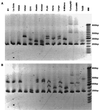Use of a heteroduplex mobility assay to detect differences in the fusion protein cleavage site coding sequence among Newcastle disease virus isolates
- PMID: 11526146
- PMCID: PMC88314
- DOI: 10.1128/JCM.39.9.3171-3178.2001
Use of a heteroduplex mobility assay to detect differences in the fusion protein cleavage site coding sequence among Newcastle disease virus isolates
Abstract
Newcastle disease virus (NDV) is an economically important pathogen of poultry that may cause clinical disease that ranges from a mild respiratory syndrome to a virulent form with high mortality, depending on an isolate's pathotype. Infections with virulent NDV strains are required to be reported by member nations to the Office of International Epizootes (OIE). The primary determinant for virulence among NDV isolates is the presence or absence of dibasic amino acids in the fusion (F) protein cleavage activation site. Along with biological virulence determinations as the definitive tests, OIE accepts reporting of the F protein cleavage site sequence of NDV isolates as a virulence criterion. Nucleotide sequence data for many NDV isolates recently isolated from infected chickens and other avian species worldwide have been deposited in GenBank. Consequently, viral genomic information surrounding the F protein cleavage site coding sequence was used to develop a heteroduplex mobility assay (HMA) to aid in further identification of molecular markers as predictors of NDV virulence. Using common vaccine strains as a reference, we were able to distinguish virulent viruses among NDV isolates that correlated with phylogenetic analysis of the nucleotide sequence. This technique was also used to examine NDV isolates not previously characterized. We were able to distinguish vaccine-like viruses from other isolates potentially virulent for chickens. This technique will help improve international harmonization of veterinary biologics as set forth by the OIE and the Veterinary International Cooperation on Harmonization of Technical Requirements of Veterinary Medicinal Products. Ultimately, the HMA could be used for initial screening among a large number of isolates and rapid identification of potentially virulent NDV that continue to threaten commercial poultry worldwide.
Figures



References
-
- Alexander D J. Newcastle disease and other avian Paramyxoviridae infections. In: Calnek B W, Barnes H J, Beard C W, Reid W M, Yoder H W Jr, editors. Diseases of poultry. 10th ed. Ames, Iowa: Iowa State University Press; 1997. pp. 541–570.
-
- Alexander D J. Newcastle disease. In: Purchase H G, Arp L H, Domermuth C H, Pearson J E, editors. A laboratory manual for the isolation and identification of avian pathogens. 3rd ed. Kennett Square, Pa: American Association of Avian Pathologists, Inc.; 1989. pp. 114–120.
-
- Alexander D J, Manville R J, Kemp P A, Parsons G, Collins M S, Brockman S, Russell P H, Lister S A. Use of monoclonal antibodies in the characterisation of avian paramyxovirus 1 (Newcastle disease virus) isolates submitted to an international reference laboratory. Avian Pathol. 1987;16:553–565. - PubMed
-
- Awan M A, Otte M J, James A D. The epidemiology of Newcastle disease in rural poultry: a review. Avian Pathol. 1994;23:405–423. - PubMed
-
- Chezzi C, Schoub B D. Differentiation between vaccine-related and wild-type polioviruses using a heteroduplex mobility assay. J Virol Methods. 1996;62:93–102. - PubMed
Publication types
MeSH terms
Substances
Associated data
- Actions
- Actions
- Actions
- Actions
- Actions
- Actions
LinkOut - more resources
Full Text Sources

